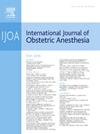2014-2017年选择性剖宫产常规左子宫移位术前及术后新生儿酸碱状况回顾性队列研究
IF 2.6
3区 医学
Q2 ANESTHESIOLOGY
引用次数: 0
摘要
背景:在剖宫产过程中维持左子宫位移是几十年来缓解腹主动脉压迫的推荐方法。我们在2017年发表了一项研究,该研究表明,当母体收缩压维持在晶体剂负荷和预防性苯肾上腺素输注下时,与15度左倾相比,母体仰卧位不会损害新生儿酸碱状态,因此我们放弃了我们机构的这种做法。我们假设,在我们的改变之前和之后,在脊髓麻醉下择期剖宫产分娩的新生儿中,平均脐动脉基底过剩没有差异。方法通过回顾性分析2014年(“有倾斜”)和2017年(“无倾斜”)的电子健康记录,获得孕产妇人口统计学和新生儿结局。连续选取脊髓麻醉下足月单胎妊娠择期剖宫产病例。常规做法包括晶体结膜和预防性输注苯肾上腺素以维持母体基线收缩压。主要终点为平均脐动脉基底过量,两组间采用非配对t检验进行分析。结果“有倾斜”(n=201)与“无倾斜”(n=202)的脐动、静脉基底过量或pH值无差异。在新生儿脐动脉基底过量、pH值、Apgar评分或复苏需要方面,组间异常值的数量也无显著差异。结论与历史队列相比,脊髓麻醉下剖宫产择期患者手术台倾斜不影响新生儿酸碱状态。本文章由计算机程序翻译,如有差异,请以英文原文为准。
Neonatal acid-base status before and after discontinuing routine left uterine displacement for elective cesarean delivery: a retrospective cohort study (2014–2017)
Background
Maintaining left uterine displacement during cesarean delivery has been a decades-long recommendation to mitigate aortocaval compression. We abandoned the practice at our institution following the publication in 2017 of our study showing that maternal supine position did not impair neonatal acid-base status compared with 15 degrees left tilt, when maternal systolic blood pressure was maintained with a crystalloid coload and prophylactic phenylephrine infusion. We hypothesized that there would be no difference in mean umbilical artery base excess between neonates delivered by elective cesarean section with spinal anesthesia during the periods before and after our change in practice.
Methods
Maternal demographics and neonatal outcomes were obtained by retrospective review of electronic health records in 2014 (‘with tilt’) and 2017 (‘no tilt’). Cases with elective cesarean delivery of singleton pregnancies at term with spinal anesthesia were selected consecutively in each year. Routine practice included crystalloid coloading and prophylactic phenylephrine infusion targeted at maintaining maternal baseline systolic blood pressure. The primary outcome was mean umbilical artery base excess, analyzed using an unpaired t-test for two groups.
Results
There were no differences in umbilical artery or vein base excess or pH ‘with tilt’ (n=201) vs. ‘no tilt’ (n=202). There was also no significant difference between groups in the number of outliers with respect to neonatal umbilical artery base excess, pH, Apgar scores or need for resuscitation.
Conclusion
No tilt of surgical table in elective cesarean delivery cases with spinal anesthesia did not affect neonatal acid-base status compared with a historical cohort when maternal tilt was routine.
求助全文
通过发布文献求助,成功后即可免费获取论文全文。
去求助
来源期刊
CiteScore
4.70
自引率
7.10%
发文量
285
审稿时长
58 days
期刊介绍:
The International Journal of Obstetric Anesthesia is the only journal publishing original articles devoted exclusively to obstetric anesthesia and bringing together all three of its principal components; anesthesia care for operative delivery and the perioperative period, pain relief in labour and care of the critically ill obstetric patient.
• Original research (both clinical and laboratory), short reports and case reports will be considered.
• The journal also publishes invited review articles and debates on topical and controversial subjects in the area of obstetric anesthesia.
• Articles on related topics such as perinatal physiology and pharmacology and all subjects of importance to obstetric anaesthetists/anesthesiologists are also welcome.
The journal is peer-reviewed by international experts. Scholarship is stressed to include the focus on discovery, application of knowledge across fields, and informing the medical community. Through the peer-review process, we hope to attest to the quality of scholarships and guide the Journal to extend and transform knowledge in this important and expanding area.

 求助内容:
求助内容: 应助结果提醒方式:
应助结果提醒方式:


